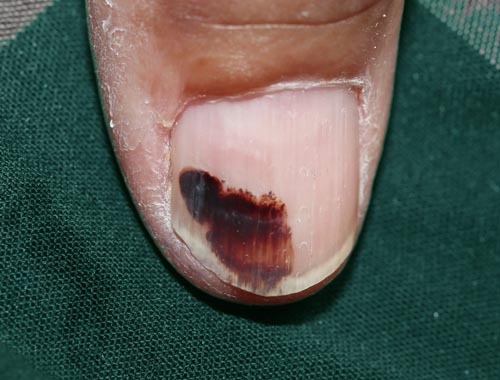Subungual Hematoma

Published: 18 Jun 2025
ICD9: 923.3 ICD10: S60.10XA ICD11: NC50
A subungual hematoma is essentially a bruise under your fingernail or toenail.
It's caused by trauma to the nail bed, the tissue underneath the nail, resulting in bleeding. The blood gets trapped between the nail plate (the hard part of your nail) and the nail bed.
Here's a breakdown:
![]() Subungual: Means "under the nail"
Subungual: Means "under the nail"
![]() Hematoma: A localized collection of blood outside of blood vessels.
Hematoma: A localized collection of blood outside of blood vessels.
Causes:
![]() Trauma: This is the most common cause. Examples include:
Trauma: This is the most common cause. Examples include:![]()

![]() Stubbing your toe
Stubbing your toe![]()

![]() Dropping something heavy on your toe or finger
Dropping something heavy on your toe or finger![]()

![]() Wearing shoes that are too tight, especially during athletic activities (common in runners)
Wearing shoes that are too tight, especially during athletic activities (common in runners)![]()

![]() Repetitive trauma, like from hiking downhill
Repetitive trauma, like from hiking downhill
Symptoms:
![]() Pain: The amount of pain can vary depending on the size of the hematoma and the pressure it exerts on the nail bed.
Pain: The amount of pain can vary depending on the size of the hematoma and the pressure it exerts on the nail bed.
![]() Discoloration: The area under the nail will appear red, purple, blue, or black. Over time, it may turn brown or dark green as the blood breaks down.
Discoloration: The area under the nail will appear red, purple, blue, or black. Over time, it may turn brown or dark green as the blood breaks down.
![]() Pressure: A feeling of pressure or throbbing under the nail.
Pressure: A feeling of pressure or throbbing under the nail.
![]() Nail lifting: In severe cases, the hematoma can cause the nail to detach from the nail bed.
Nail lifting: In severe cases, the hematoma can cause the nail to detach from the nail bed.
Treatment:
The treatment for a subungual hematoma depends on its size and the amount of pain:
![]() Small, painless hematomas: May not require any treatment. They will usually resolve on their own over several weeks or months as the blood is reabsorbed.
Small, painless hematomas: May not require any treatment. They will usually resolve on their own over several weeks or months as the blood is reabsorbed.
![]() Large, painful hematomas: May require drainage to relieve the pressure. This is usually done by a doctor who will use a sterile needle or heated instrument to make a small hole in the nail to allow the blood to escape. This procedure is called trephination. Do not attempt to do this yourself! You risk infection and further injury.
Large, painful hematomas: May require drainage to relieve the pressure. This is usually done by a doctor who will use a sterile needle or heated instrument to make a small hole in the nail to allow the blood to escape. This procedure is called trephination. Do not attempt to do this yourself! You risk infection and further injury.
![]() If the nail is severely damaged or detached: The doctor may need to remove the nail. In some cases, they may also repair any underlying nail bed injuries.
If the nail is severely damaged or detached: The doctor may need to remove the nail. In some cases, they may also repair any underlying nail bed injuries.
![]() Tetanus booster: Your doctor may recommend a tetanus booster, especially if the injury involved a puncture wound.
Tetanus booster: Your doctor may recommend a tetanus booster, especially if the injury involved a puncture wound.
When to see a doctor:
![]() If the pain is severe
If the pain is severe
![]() If the hematoma covers more than 25% of the nail
If the hematoma covers more than 25% of the nail
![]() If the nail is significantly detached or deformed
If the nail is significantly detached or deformed
![]() If there are signs of infection (redness, swelling, pus)
If there are signs of infection (redness, swelling, pus)
![]() If you have diabetes or other conditions that impair healing
If you have diabetes or other conditions that impair healing
![]() If you are unable to bear weight on the affected foot
If you are unable to bear weight on the affected foot
![]() If you have numbness or tingling in the toe or finger
If you have numbness or tingling in the toe or finger
In summary, a subungual hematoma is a bruise under the nail, usually caused by trauma. Treatment depends on the size and symptoms. See a doctor for large, painful hematomas or if you have concerns about infection or other complications.